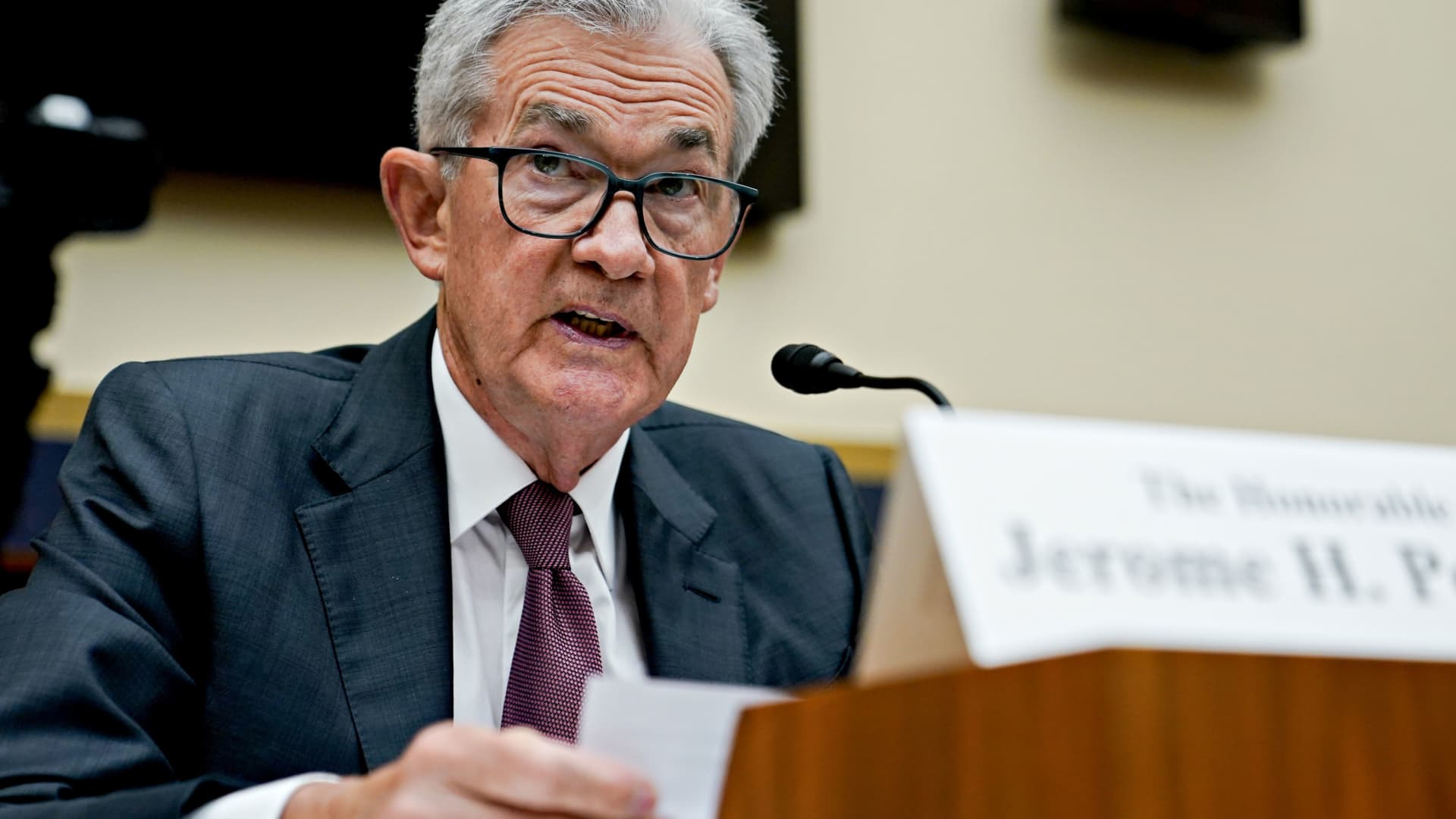Jerome Powell, chair of the Federal Reserve, during a House Financial Services Committee hearing in Washington, D.C., on June 21, 2023.
Nathan Howard | Bloomberg | Getty Images
Federal Reserve Chairman Jerome Powell heads to Capitol Hill on Wednesday with markets intent on getting more clarity about how the central bank plans on proceeding with monetary policy this year.
The past several months have seen a changing dynamic between financial markets and the Fed over the pace and timing of expected interest rate cuts this year. Markets have had to adjust their collective view from a highly accommodative central bank to one that’s more cautious and deliberate.
With his congressionally mandated testimony coming before the House on Wednesday and the Senate on Thursday, Powell will be tasked with providing a sharper view — and not rocking the boat for a nervous Wall Street.
“The question now for the market is to glean any information on when the Fed will begin employing rate cuts and how many,” said Quincy Krosby, chief global strategist at LPL Financial. “He’s not going to answer that necessarily. But if there is any change, any nuance, that is what the market wants to see.”
Central to the question of how the Fed acts from here on out is its view on inflation and how Powell expresses that. In recent weeks, he and others have expressed satisfaction with the trend in prices along with apprehension that risks still lurk, saying it’s too early to ease up on monetary policy.
Markets currently anticipate the Fed will begin cutting in June and enact the equivalent of four quarter-percentage-point cuts in total this year, according to futures market pricing gauged by the CME Group. Policymakers in December indicated three cuts and mostly have avoided providing a timetable.
Mixed signals complicate the message
On the inflation issue, the data had been cooperating for the most part.
Inflation readings in the latter part of 2023 showed a clear trend toward the Fed’s 2% target. However, January brought a jolt, showing that consumer prices, particularly in shelter costs, remained stubbornly higher and posed a threat to the trend.
Powell will have to synthesize the recent trends carefully as he speaks first to the House Financial Services Committee on Wednesday, then the Senate Banking Committee the day after.
“The message very much is not going to be ‘mission accomplished,’ but ‘we’ve made a lot of progress, we anticipate rate cuts are coming,'” said Joseph LaVorgna, chief economist at SMBC Nikko Securities. “That to me is what I think will be the central message.”
Powell’s testimony before Congress comes at a ticklish time for markets: After breaching historic highs, major stock averages have sold off this week amid ongoing concern about where rates are headed and a suddenly uncertain outlook for a few of the Big Tech names that have been driving prices higher.
Both conditions are concerning for policymakers. Big jumps in risk asset prices could reflect loose financial conditions that might cause the Fed to hold tight on policy, while a less certain environment could raise fears about staying too high for too long on rates.
Powell “cannot deviate at all from the ‘data-dependent, but we really want to cut rates’ approach the Committee has committed to,” wrote Steven Ricchiuto, U.S. chief economist at Mizuho Securities. “Sharp swings in financial conditions can easily work at cross-purposes to the Committee’s objective: maintaining tight labor market conditions while also keeping inflation expectations and long-term rates well anchored,” he said, referring to the policy-setting Federal Open Market Committee.
Political concerns
There are also other dynamics facing Powell. Several economists, including LaVorgna, see labor conditions weakening despite the apparent strength of a 3.7% unemployment rate. Also, a stunning runup in cryptocurrency prices recently suggests untethered risk-taking that could indicate too much liquidity washing around the system.
Indeed, Atlanta Fed President Raphael Bostic on Monday released an essay in which he expressed concern about potential “pent-up exuberance” that could be unleashed after rate cuts start.
“We don’t think monetary policy itself is loose, but the Fed and Powell have to wonder about this nonetheless, in view of these extant ‘remnants’ of speculation,” strategists at Macquarie said in a client note Tuesday. “The point is that small speculative frenzies that come out of nowhere should make it even more difficult for the Fed to sound dovish at this juncture.”
Finally, there are political considerations.
Along with the usual pressure that comes during presidential election years, there have been calls on the Hill for Powell and his cohorts to start cutting rates. Sen. Elizabeth Warren, D-Mass., no fan of Powell to start with, called in January for the Fed to start cutting as higher rates are especially painful for lower-income households.
They’ll get a chance to hash out the issue Thursday as Warren is a member of the Senate banking panel.
Powell needs to make “a case for why the Fed needs to address rates in anticipation of where inflation is likely to be not where it is at the moment,” LaVorgna said. “You’re going to be damned if you do, damned if you don’t. So, I think you need a very solid framework.”
Don’t miss these stories from CNBC PRO:
